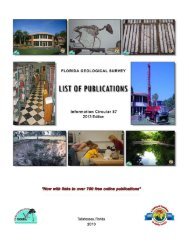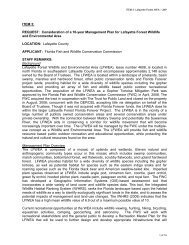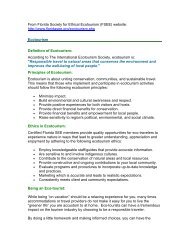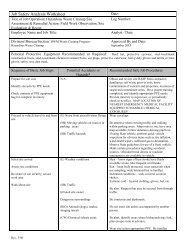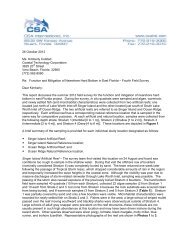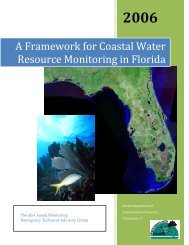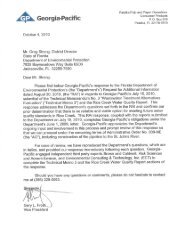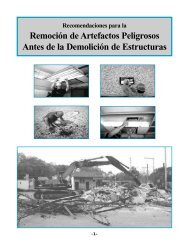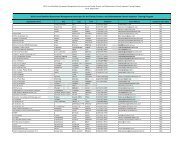Jonathan Dickinson State Park
Jonathan Dickinson State Park
Jonathan Dickinson State Park
Create successful ePaper yourself
Turn your PDF publications into a flip-book with our unique Google optimized e-Paper software.
<strong>Jonathan</strong> <strong>Dickinson</strong> <strong>State</strong> <strong>Park</strong> 79<br />
plants. The duration of inundation (hydroperiod) influences the dominant plant<br />
communities. Maidencane (Panicum hemitomon) for example, cannot tolerate continuous<br />
flooding and requires a drawdown during a portion of the annual hydroperiod (Kushian<br />
in Ecosystems of Florida, 1991). Thus, it is significant that both reference sites contain<br />
areas dominated by maidencane, usually in the deepest area. A band of St. John’s-wort<br />
(Hypericum fasciculatum) occurs landward of the maidencane zone. The shallow rooted<br />
species, such as St. John’s-wort (Hypericum spp.), are killed by drying and fire but quickly<br />
reseed during wet periods, while rhizomatous species such as maidencane survive these<br />
extremes underground. As a result, zones of dominance migrate up and down slope in<br />
response to changing water conditions (B. H. Winchester, personal communication to<br />
Kushian in Ecosystems of Florida, 1991).<br />
Due to variable soil conditions and hydroperiods the ecotone between marsh and<br />
flatwoods is often reticulate in nature. This is the palmetto “edge” often seen around<br />
depression marshes. It is here that we find the highest diversity of herbaceous plant<br />
species associated with these wetlands. The wetland boundary will most often occur in<br />
this ecotone.<br />
The marshes differ in the degree of slope along the wetland/upland boundary which is<br />
expressed as differences in the vegetative transition within the fringe zone of Serenoa<br />
repens (saw palmetto). The fringing palmetto zone along the northern reference site<br />
consists of patches of Serenoa repens intermixed with areas dominated by grasses or<br />
gallberry. The southern marsh site has a steeper gradient at the edge and a more<br />
apparent community change from the wetland to the upland. The palmetto edge at the<br />
southern reference site is continuous and distinct.<br />
GENERAL DELINEATION PROCEDURE<br />
The marshes chosen as reference sites are identifiable as wetlands by direct use of the<br />
wetland definition. Further, each reference site is represented on the Martin County soil<br />
survey as a depressional mapping unit (Waveland sand, depressional). Areas mapped<br />
in County Soil surveys as frequently flooded or depressional are wetlands contingent on<br />
in-situ confirmation of the hydric soil characteristics (subsection 62-340.300(2)(c), F.A.C.).<br />
Hydric soil indicators within these areas are readily confirmed. Implementing subsection<br />
62-340.300(2)(c), F.A.C., is a technical exercise that most often requires the expertise of a<br />
soil scientist because it is necessary to located the edge of the depressional area as<br />
mapped on the soil map. Once the edge of the depressional unit is located, then the other<br />
provisions of Chapter 62-340, F.A.C., must be examined to discern whether the wetland<br />
being delineated extends landward of the depressional area.<br />
NORTHERN MARSH<br />
• Observations begin in the marsh at the edge of the “Hypericum zone”, a site clearly<br />
within the depressional soil mapping unit. Hypericum fasciculatum is an ecologically<br />
obligate wetland plant which often develops as an apparent broad band of vegetation<br />
within inundated areas of a marsh. Vegetative dominance in this zone meets the<br />
provisions of subsection 62-340.300(2)(a), F.A.C. Further supporting this conclusion, at





